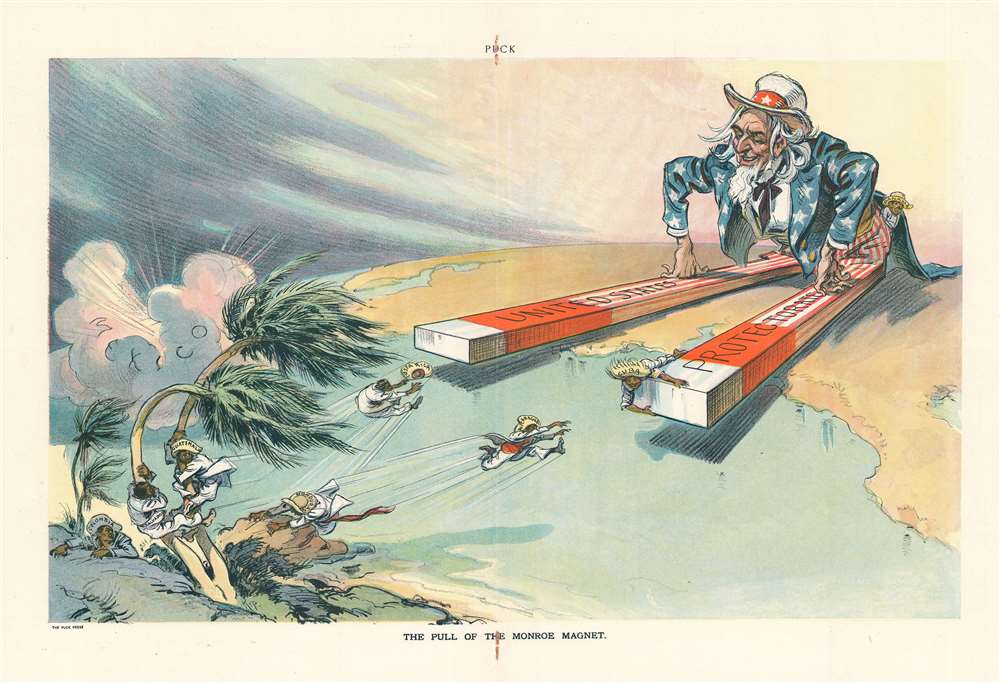Digital Image: 1913 Puck Magazine Political Cartoon of American Protectorates in Latin America
MonroeMagnet-puck-1913_d
Title
1913 (undated) 12.5 x 18.5 in (31.75 x 46.99 cm)
Description
FOR THE ORIGINAL ANTIQUE MAP, WITH HISTORICAL ANALYSIS, CLICK HERE.
Digital Map Information
Geographicus maintains an archive of high-resolution rare map scans. We scan our maps at 300 DPI or higher, with newer images being 600 DPI, (either TIFF or JPEG, depending on when the scan was done) which is most cases in suitable for enlargement and printing.
Delivery
Once you purchase our digital scan service, you will receive a download link via email - usually within seconds. Digital orders are delivered as ZIP files, an industry standard file compression protocol that any computer should be able to unpack. Some of our files are very large, and can take some time to download. Most files are saved into your computer's 'Downloads' folder. All delivery is electronic. No physical product is shipped.
Credit and Scope of Use
You can use your digial image any way you want! Our digital images are unrestricted by copyright and can be used, modified, and published freely. The textual description that accompanies the original antique map is not included in the sale of digital images and remains protected by copyright. That said, we put significant care and effort into scanning and editing these maps, and we’d appreciate a credit when possible. Should you wish to credit us, please use the following credit line:
Courtesy of Geographicus Rare Antique Maps (https://www.geographicus.com).
How Large Can I Print?
In general, at 300 DPI, you should at least be able to double the size of the actual image, more so with our 600 DPI images. So, if the original was 10 x 12 inches, you can print at 20 x 24 inches, without quality loss. If your display requirements can accommodate some loss in image quality, you can make it even larger. That being said, no quality of scan will allow you to blow up at 10 x 12 inch map to wall size without significant quality loss. For more information, it is best consult a printer or reprographics specialist.
Refunds
If the high resolution image you ordered is unavailable, we will fully refund your purchase. Otherwise, digital images scans are a service, not a tangible product, and cannot be returned or refunded once the download link is used.
Cartographer
Udo J. Keppler (April 4, 1872 - July 4, 1956) was an American political cartoonist, Native American advocate, and publisher, known as Joseph Keppler Jr. beginning in 1894. The son of Joseph Keppler (1838 - 1894), the founder of Puck magazine, he was born in St. Louis, Missouri, and graduated from the Columbia Institute in 1888. Between 1890 and 1891, Keppler studied in Germany, and worked for Puck from 1890 until 1914. He contributed cartoons to the magazine beginning that year and became a co-owner of the magazine after his father's death in 1894. He changed his name to Joseph Keppler Jr. after he inherited his father's position at the magazine. He sold Puck in December 1913, and stayed on as art director for another four months. After the sale of Puck, Keppler contributed to Judge and Leslie's Weekly until 1915, and retired in 1920. He moved to La Jolla, California, in 1946 where he died ten years later. He married Louise (Lulu) Eva Bechtel, a match opposed by his mother and sister, on April 4, 1895. More by this mapmaker...

